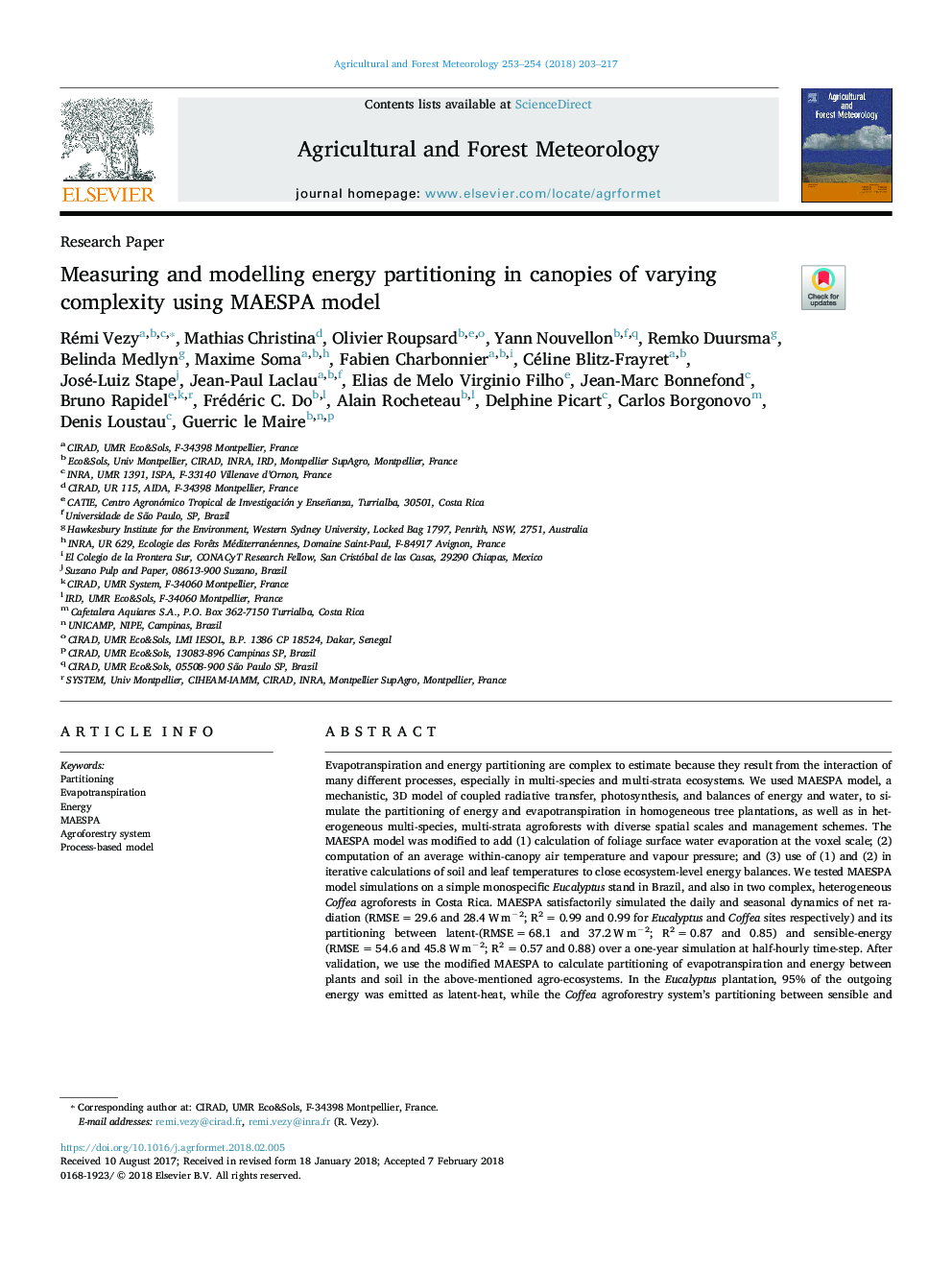| کد مقاله | کد نشریه | سال انتشار | مقاله انگلیسی | نسخه تمام متن |
|---|---|---|---|---|
| 6536750 | 1420849 | 2018 | 15 صفحه PDF | دانلود رایگان |
عنوان انگلیسی مقاله ISI
Measuring and modelling energy partitioning in canopies of varying complexity using MAESPA model
دانلود مقاله + سفارش ترجمه
دانلود مقاله ISI انگلیسی
رایگان برای ایرانیان
کلمات کلیدی
موضوعات مرتبط
مهندسی و علوم پایه
علوم زمین و سیارات
علم هواشناسی
پیش نمایش صفحه اول مقاله

چکیده انگلیسی
Evapotranspiration and energy partitioning are complex to estimate because they result from the interaction of many different processes, especially in multi-species and multi-strata ecosystems. We used MAESPA model, a mechanistic, 3D model of coupled radiative transfer, photosynthesis, and balances of energy and water, to simulate the partitioning of energy and evapotranspiration in homogeneous tree plantations, as well as in heterogeneous multi-species, multi-strata agroforests with diverse spatial scales and management schemes. The MAESPA model was modified to add (1) calculation of foliage surface water evaporation at the voxel scale; (2) computation of an average within-canopy air temperature and vapour pressure; and (3) use of (1) and (2) in iterative calculations of soil and leaf temperatures to close ecosystem-level energy balances. We tested MAESPA model simulations on a simple monospecific Eucalyptus stand in Brazil, and also in two complex, heterogeneous Coffea agroforests in Costa Rica. MAESPA satisfactorily simulated the daily and seasonal dynamics of net radiation (RMSEâ¯=â¯29.6 and 28.4â¯Wâ¯mâ2; R2â¯=â¯0.99 and 0.99 for Eucalyptus and Coffea sites respectively) and its partitioning between latent-(RMSEâ¯=â¯68.1 and 37.2â¯Wâ¯mâ2; R2â¯=â¯0.87 and 0.85) and sensible-energy (RMSEâ¯=â¯54.6 and 45.8â¯Wâ¯mâ2; R2â¯=â¯0.57 and 0.88) over a one-year simulation at half-hourly time-step. After validation, we use the modified MAESPA to calculate partitioning of evapotranspiration and energy between plants and soil in the above-mentioned agro-ecosystems. In the Eucalyptus plantation, 95% of the outgoing energy was emitted as latent-heat, while the Coffea agroforestry system's partitioning between sensible and latent-heat fluxes was roughly equal. We conclude that MAESPA process-based model has an appropriate balance of detail, accuracy, and computational speed to be applicable to simple or complex forest ecosystems and at different scales for energy and evapotranspiration partitioning.
ناشر
Database: Elsevier - ScienceDirect (ساینس دایرکت)
Journal: Agricultural and Forest Meteorology - Volumes 253â254, 1 May 2018, Pages 203-217
Journal: Agricultural and Forest Meteorology - Volumes 253â254, 1 May 2018, Pages 203-217
نویسندگان
Rémi Vezy, Mathias Christina, Olivier Roupsard, Yann Nouvellon, Remko Duursma, Belinda Medlyn, Maxime Soma, Fabien Charbonnier, Céline Blitz-Frayret, José-Luiz Stape, Jean-Paul Laclau, Elias de Melo Virginio Filho, Jean-Marc Bonnefond, Bruno Rapidel,